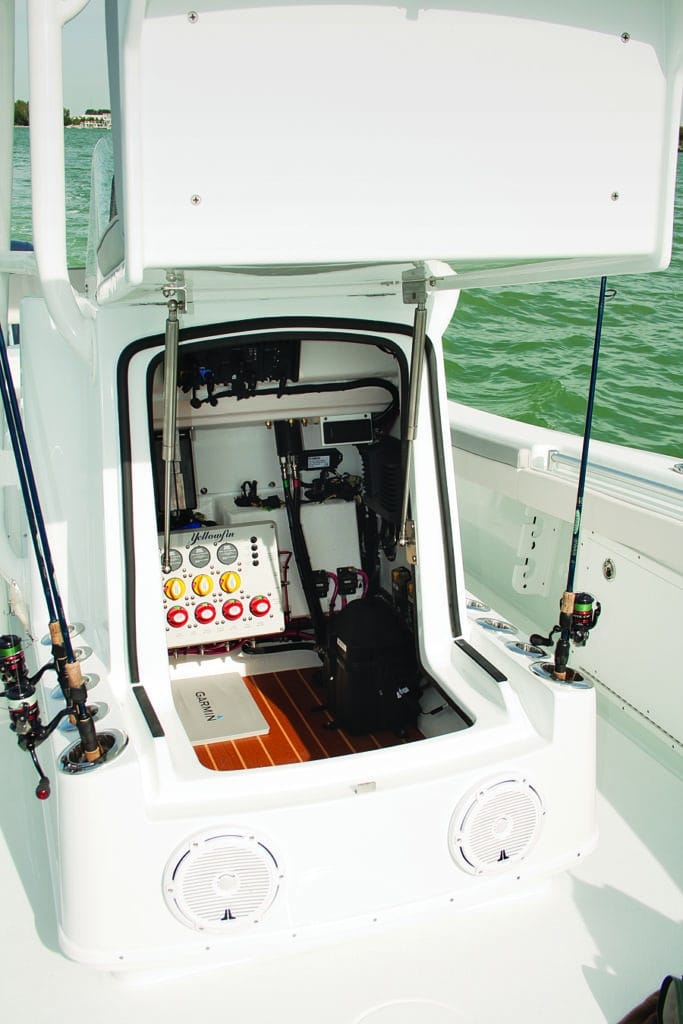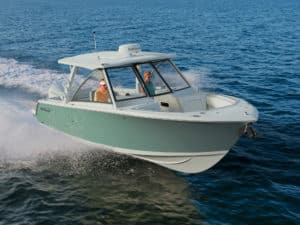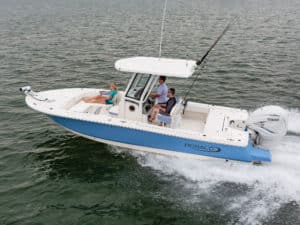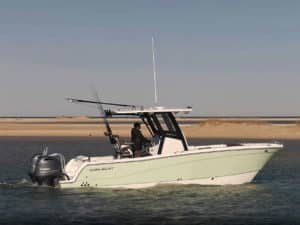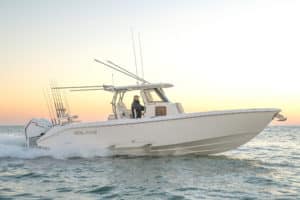Capt. Mark “Lebo” Liberman proposed a simple plan for our Fish Trial of the new 26 from Yellowfin Yachts, as we loaded gear into the boat in the parking lot at Centennial Park launch ramp in Sarasota, Florida.
“Let’s hunt the crab-pot buoys off the beach for tripletail,” Liberman suggested. “That way we get to run the boat a lot to see how she performs, and hopefully we’ll catch a fish or two.
“When we’re done with that, we’ll come back in and fish around the keys [in Sarasota Bay] for flounder and spotted seatrout.”
“Sounds good to me,” I answered. The sun was out, but gusty northeast winds behind a mid-November cold front meant we’d also get to see how the 26 handled choppy water and deflected spray while running in the Gulf of Mexico. I bundled up, climbed aboard and, as Liberman backed the trailer down, launched the boat.
Filling a Void
The 26 fills a fairly wide slot in the Yellowfin stable between the 24 Bay and the offshore-oriented 29. With the addition of the 26, the line now includes 11 models stretching from the 17 Skiff to the Yellowfin 42.
My test took place on the first Yellowfin 26 — hull No. 1 — and the company was still fine-tuning some of the features. For example, this boat had manual jack plates for the twin Yamaha F200 four-cylinder outboards. That allows Yellowfin to adjust and find the optimum engine height before going into full production — a critical factor with this single-step hull.
In addition to the step amidships, the running surface stops 19 inches short of the transom, with a 5- to 6-inch elevation in the hull as it extends aft. This helps keep the propellers in cleaner water for a better bite. Based on my experience, I’d say that Yellowfin has nailed the hull design because the boat performed flawlessly on test day, achieving exceptional fuel efficiency and top speed.
Before heading out through New Pass Inlet, we stopped at the New Pass Grill & Bait Shop for two-dozen live shrimp to tempt any tripletail we found under the buoys. It was hardly a test for the 50-gallon livewell built into the seating module of the 26. It will hold at least 100 live pilchards by my estimation.
This center-console boat reflects a distinctive blend of offshore- and -bay-boat features. The upright livewell behind the helm seating and available twin outboards definitely speak to offshore anglers, while the elevated aft casting deck caters to inshore fishing enthusiasts. A level foredeck is standard, but you can order an optional elevated foredeck ($3,700), which adds even more appeal for inshore anglers.
Blustery Buoy Hunt
As expected, the wind was howling up to 20 knots outside the inlet, and the farther offshore our search for tripletail took us, the bigger the waves grew. Yet, the ride aboard the 26 was as smooth as it gets, whether running up-, down- or cross-sea. Most of our hunting took place at 3,500 rpm and 35 mph, fast enough to cover a decent amount of water yet slow enough to spot the telltale brownish hue of a tripletail as we sped by the countless number of crab-pot buoys off Longboat Key.
That speed also proved to be the most efficient for the 26. We achieved 3.4 mpg, according to the Yamaha Command Link engine displays. This efficiency number equates to a maximum range of 401 miles, based on the 118-gallon fuel capacity.
As we zigzagged almost continuously from pot to pot, I also got a chance to see how the 26 cornered at speed. Not all stepped hulls are created equal: Some have a nasty tendency to “trip” and swap ends during hard lateral acceleration. Not so with the Yellowfin 26. Handling proved predictable whenever I brought it about to starboard or port at high speed. U-Flex power-assist steering with a tilt-and-lock helm made maneuvering with twin F200s a cinch.
We used the 26’s flush-mounted Garmin GPSMAP 8215 multifunction display to keep track of the water we covered to make sure we weren’t doubling back on buoys we had previously scouted. The 15-inch display fits nicely on the helm panel of the 26.
While it’s tough to stay dry on any open boat with a 20-knot wind on your beam, the bow flare of the Yellowfin 26 did an admirable of job knocking down the spray while quartering up-sea or running in the trough. When running directly into the wind or away from it, we took nary a drop. Sixteen-inch-long trim tabs helped us adjust trim angle and correct for any list.
There was room for both Liberman and me to sit at the helm seat and use the angled footrest at the base of the console. Yet when I was not driving, I stood to the side in the 19-inch-wide walkway between the gunwale and console. I used the powder-coated aluminum uprights of the T-top frame to hold on as we banked through the waves. The optional T-top featured a fabric covering and a rack of five angled rod holders across the back.
The splatter-style nonskid sole provided outstanding footing. To help keep the deck as dry as possible, deep gutters around the sealed hatches channel water aft to healthy-size -scuppers in the stern quarters.
Unfortunately, the tripletail proved nonexistent in the Gulf waters off Sarasota on this day. So we decided to head back in to Sarasota Bay to try for flounder and seatrout.
Explore Inshore
I took advantage of the time to check other interior features. This boat came with the standard level foredeck, measuring 7 feet wide and 7 feet, 2 inches long. Under the foredeck I found a massive, fully gelcoated fish locker. In the bow resides an anchor locker that easily holds 300 feet of anchor line. Molded-in recesses allow you to secure a Danforth-style anchor in the lip around the locker opening.
The console opens upward from the front, with twin gas-assist struts to prevent it from slamming shut. Though there’s no room for a marine toilet, this compartment offers easy access to supertidy helm rigging — a reflection of the kind of quality fit and finish I found throughout this boat. Inside the console, there’s room to stow light items such as jackets and camera bags. A thickly upholstered seat on the outside of the console hatch — when it’s closed — becomes a comfortable place to take a load off. We used the five rod holders on each side of the console to stow our sticks.
A recessed aluminum bow rail and padded coaming bolsters surround the foredeck area and extend aft to the stern quarters. The gunwales measure 24 inches high in the bow. Beefy, 8-inch push-down cleats (two in the bow, two amidships and two aft) keep the covering boards clear of snags.
Yellowfin has designed rope lockers into both gunwales, located amidships. We used these tilt-open compartments to quickly stow and retrieve dock lines. On the starboard gunwale, a slinky-style raw-water washdown hose remained secure in a contoured rack.
The elevated aft casting platform serves double duty: Seat backs lift up in each corner so crew members can kick back while running to and from the fishing grounds. A hatch in the middle of the aft deck provides access to the immaculate bilge rigging. Across the transom, I found four flush-mount rod holders, in addition to seven gunwale rod holders on each side of the boat.
With an aft cockpit spanning 7 feet, 6 inches with 3 feet between the livewell and the aft casting deck, the Yellowfin 26 offers plenty of room to fish astern. As I cast live shrimp from the aft cockpit to a mangrove shore that Liberman thought might hold some fish, I noted that the coaming pads in the stern met me at the knees; a later measurement confirmed inwale height at 21 inches.
We were able to put the 26 in surprisingly shallow water while fishing around the mangrove islands, even with the engines tilted down. This boat draws 18 inches with the outboards up, according to Yellowfin’s specification sheet.
On this day, we found flounder on the menu. We hooked and landed some nice-size specimens on light tackle around the keys of Sarasota Bay before deciding it was time to see how the Yellowfin 26 would perform in protected waters.
Speed Run
The twin Yamaha counterrotating F200 outboards turned Yamaha Reliance 13¾-by-21-inch, three-blade stainless-steel propellers, and we carried a half-tank of fuel, a full livewell and 370 pounds in crew. As I punched the throttle, the Yellowfin 26 vaulted to plane in just 3.1 seconds, and reached 30 mph in 5.8 seconds.
We confirmed that the best fuel economy came at 3,500 rpm and 34.8 mph, and then poured the coals to the twin Yama-haulers. Lifting and riding on a cushion of aerated water induced by the single step, the Yellowfin 26 topped out at an exhilarating 59.4 mph at 6,100 rpm. At wide-open throttle, we burned 40.2 gallons per hour, resulting in 1.47 mpg.
In previous tests of the 26, Yellowfin personnel were able to achieve 60 mph. The fact that we came so close to that mark with a fairly heavily laden boat tells me that with a bit of fine-tuning, this craft might even crest 60.
What ultimately impressed me most about the new Yellowfin 26 was not the all-out speed but rather the comfort of the ride as we hunted for fish in the choppy seas of the Gulf, as well as the ability to venture into relatively shallow water in pursuit of flounder and seatrout. I found that the Yellowfin 26 offers an outstanding combination of performance, efficiency and quality in a boat that’s versatile enough to fish just about anywhere.
PERFORMANCE
POWER Twin Yamaha F200 -four-cylinder outboards
LOAD 110 gallons of fuel, two adults, fishing gear, full livewell
TOP SPEED 59.4 mph @ 6,100 rpm
TIME TO 30 MPH 5.8 sec.
BEST MPG 3.4 @ 34.8 mph (3,500 rpm)
HULL
LOA 26 ft.
BEAM 8 ft. 8 in.
DEADRISE 20 deg.
WEIGHT 5,200 lb. (dry with power)
**DRAFT ** 18 in. (motors up)
FUEL 118 gal.
MAX POWER 400 hp
MSRP AS TESTED $145,000
Yellowfin Yachts
Bradenton, Florida
941-753-7828
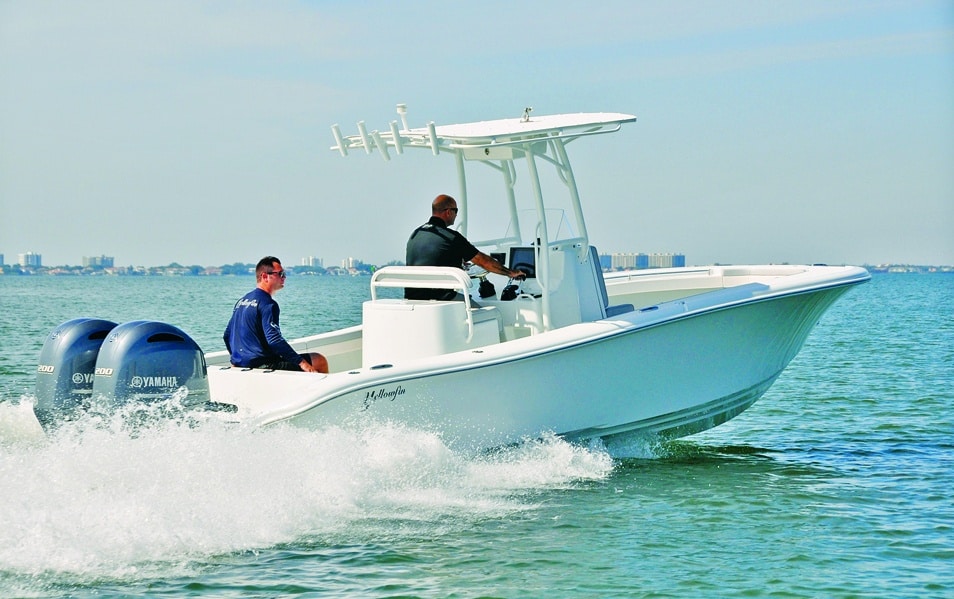
Yellowfin’s New 26
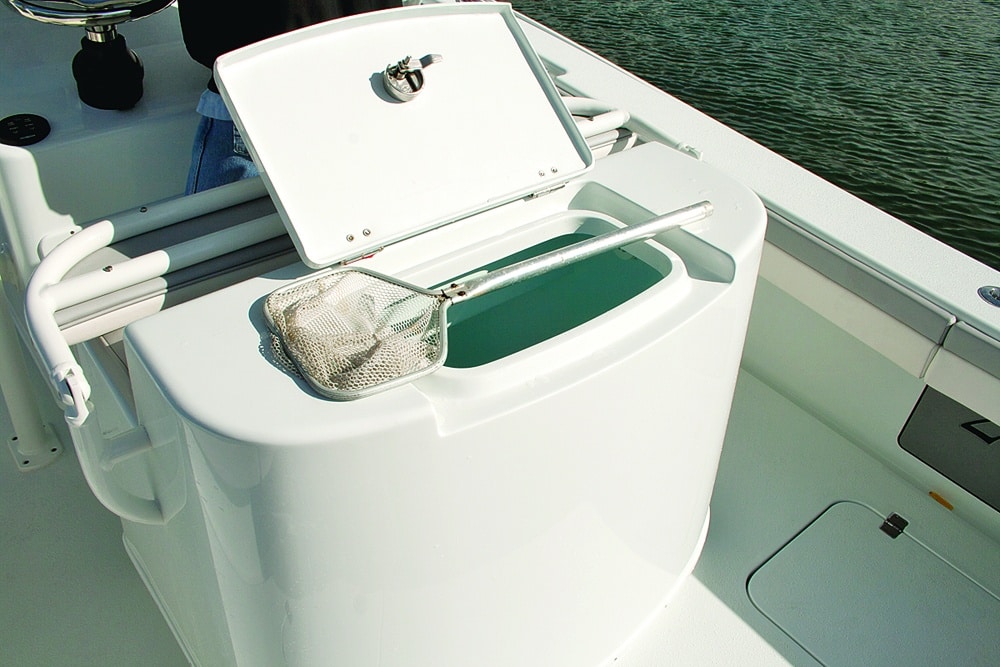
Big Livewell
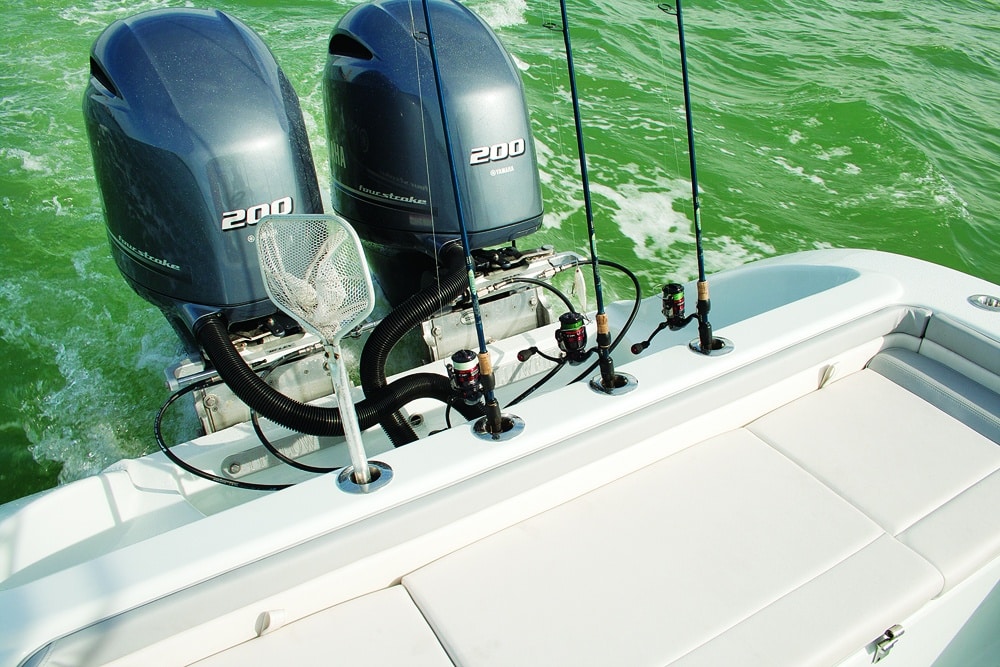
Single or Twin Outboards
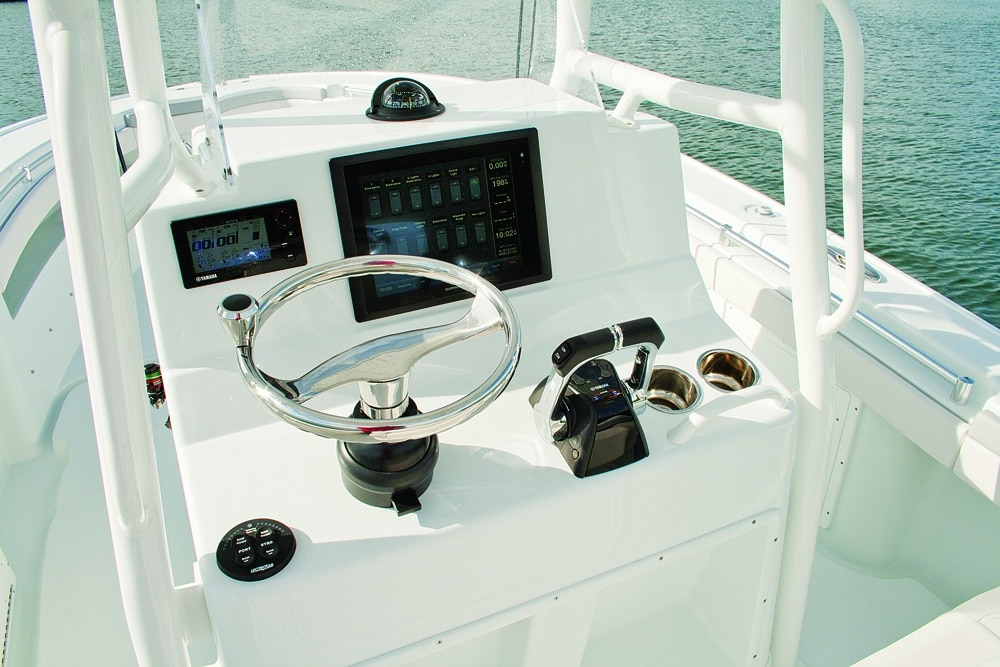
Big Helm Station
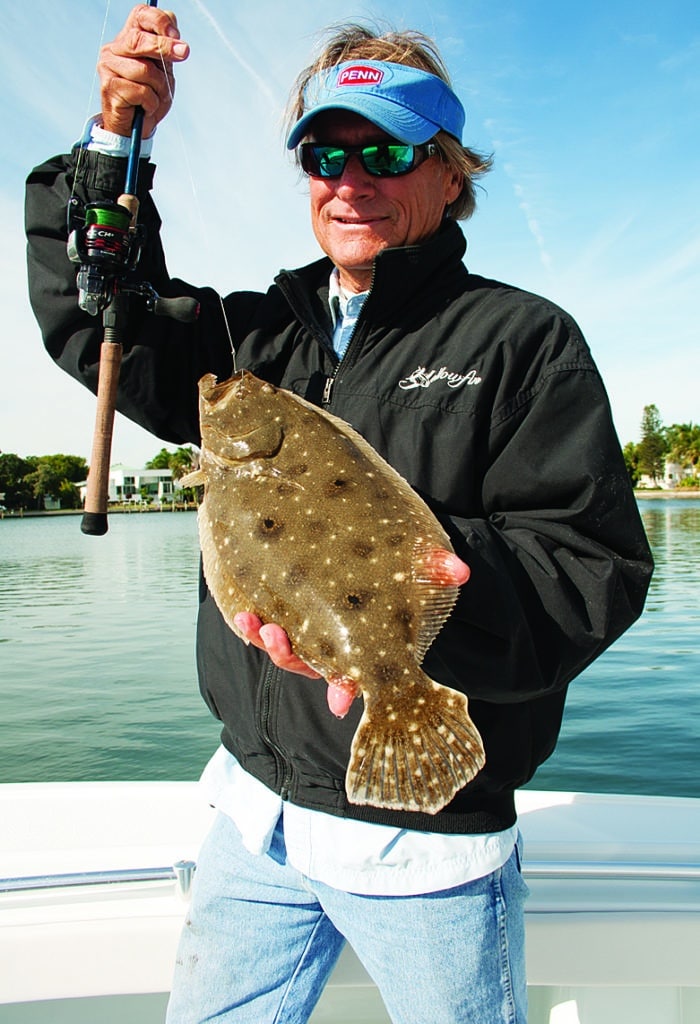
Inshore Success
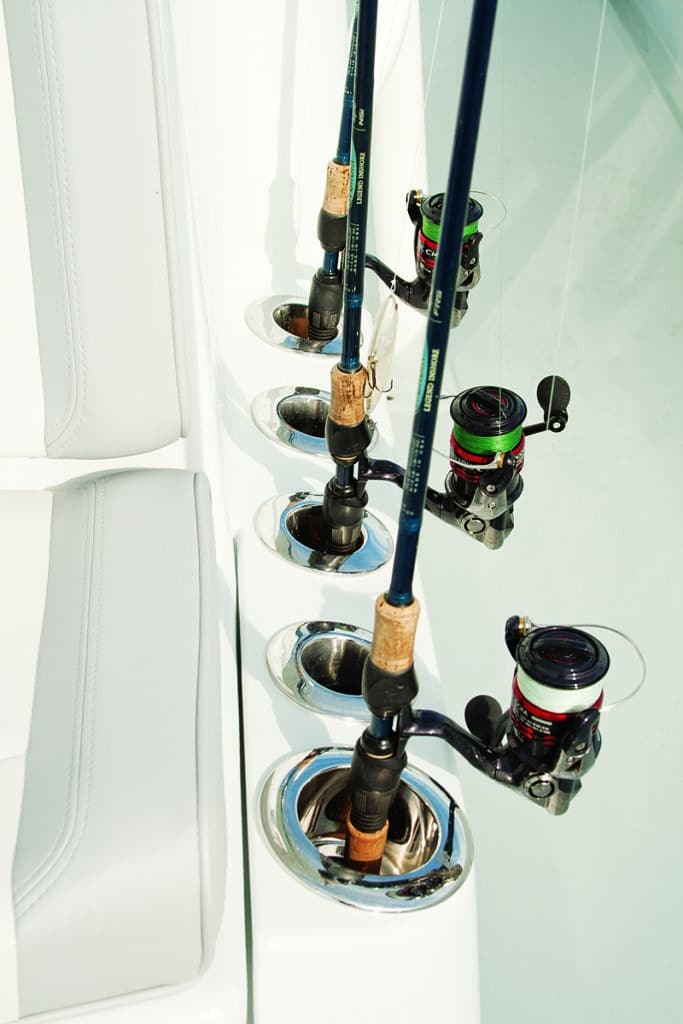
Vertical Rod Stowage
